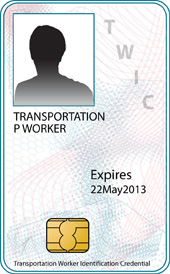
The Transportation Worker Identification Credential (or TWIC) program is a Transportation Security Administration (TSA) and U.S. Coast Guard initiative in the United States. The TWIC program provides a tamper-resistant biometric credential to maritime workers requiring unescorted access to secure areas of port facilities, outer continental shelf facilities, certain manufacturing facilities, and vessels regulated under the Maritime Transportation Security Act of 2002, or MTSA, and all U.S. Coast Guard credentialed merchant mariners.[1] As of May 2014, there were 2,999,058 people enrolled in the program.[2] Those seeking unescorted access to secure areas aboard affected vessels, and all Coast Guard credentialed merchant mariners, must obtain a TWIC. The new measures were fully implemented on April 15, 2009.[3] To obtain a TWIC, an individual must provide biographic and biometric information such as fingerprints, sit for a digital photograph and successfully pass a security threat assessment conducted by TSA.
The issued card contains a computer chip, known as an Integrated Circuit Chip (ICC), which stores the holder's information and biometric data. The chip can be read by inserting it into a reader or holding it near a "contactless" reader. There is also a magnetic strip (similar to a credit card) and a linear barcode on the back as alternative reading methods.[4]
- ^ "Frequently Asked Questions". Transportation Security Administration. Archived from the original on 10 August 2014. Retrieved 29 July 2014.
- ^ "TWIC Dashboard May 2014" (PDF). Transportation Security Administration. May 2014. Retrieved 29 July 2014.
- ^ "DHS: DHS Realigns TWIC Compliance Date". Archived from the original on 2012-02-12. Retrieved 2016-07-29.
- ^ Frequently Asked Questions: Transportation Worker Identification Credential (TWIC®) Archived 2011-12-27 at the Wayback Machine from the Transportation Security Administration. Retrieved December 22, 2011.